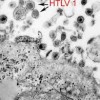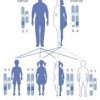HTLV I/II and HTLV III seroprevalence in blood product recipients
Abstract
Human T-cell leukemia virus type I (HTLV-I) has been strongly implicated as the etiology of adult T-cell leukemia (ATL), a T-cell type non-Hodgkin’s lymphoma with leukemic manifestations in Japan, the Caribbean, and the southeastern United States. The prevalence of serum antibody specific for one core antigen of HTLV-I, p24, has been found to be high in patients with ATL, and higher in relatives of these patients than in general population controls.… Read more


